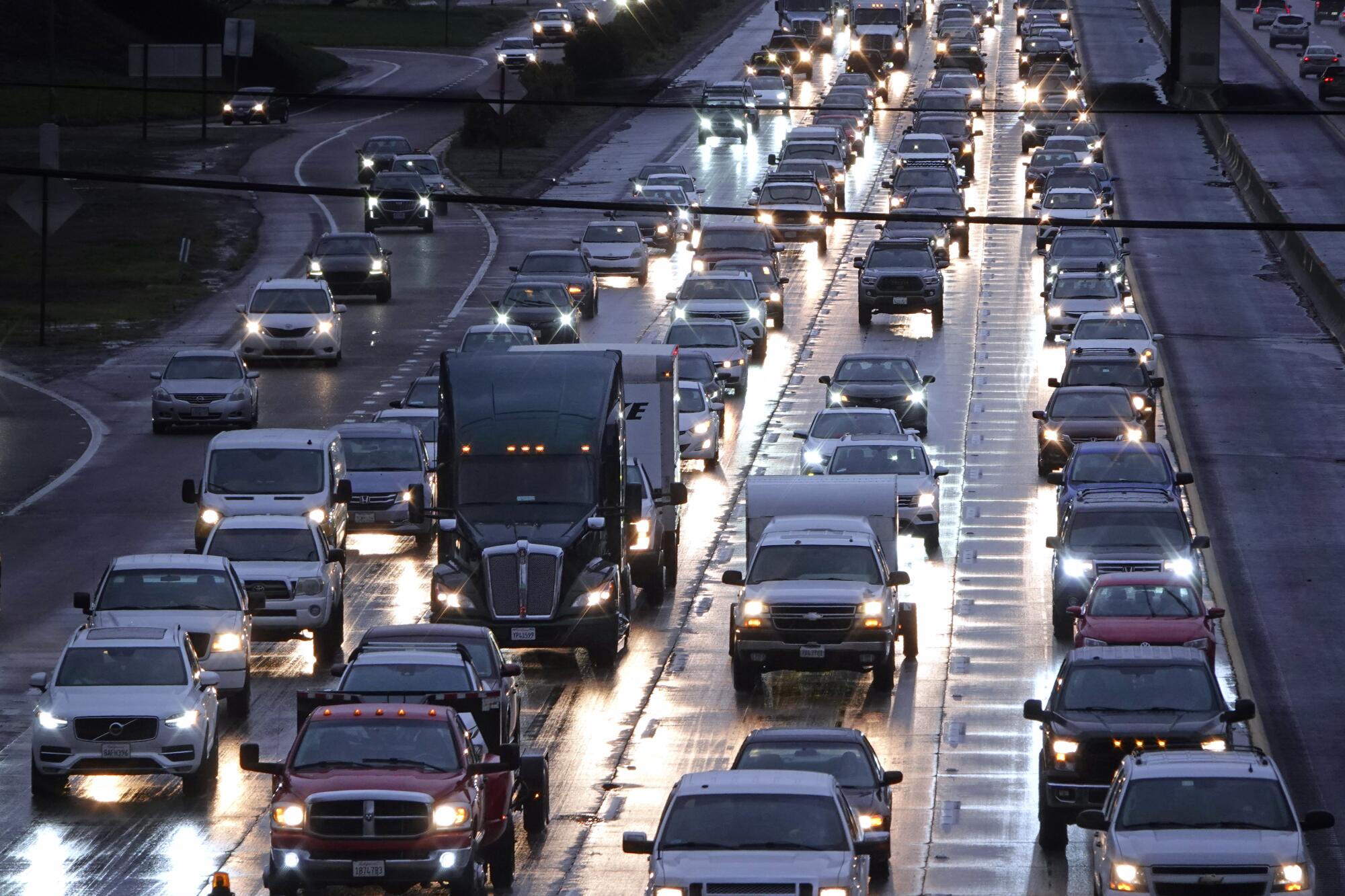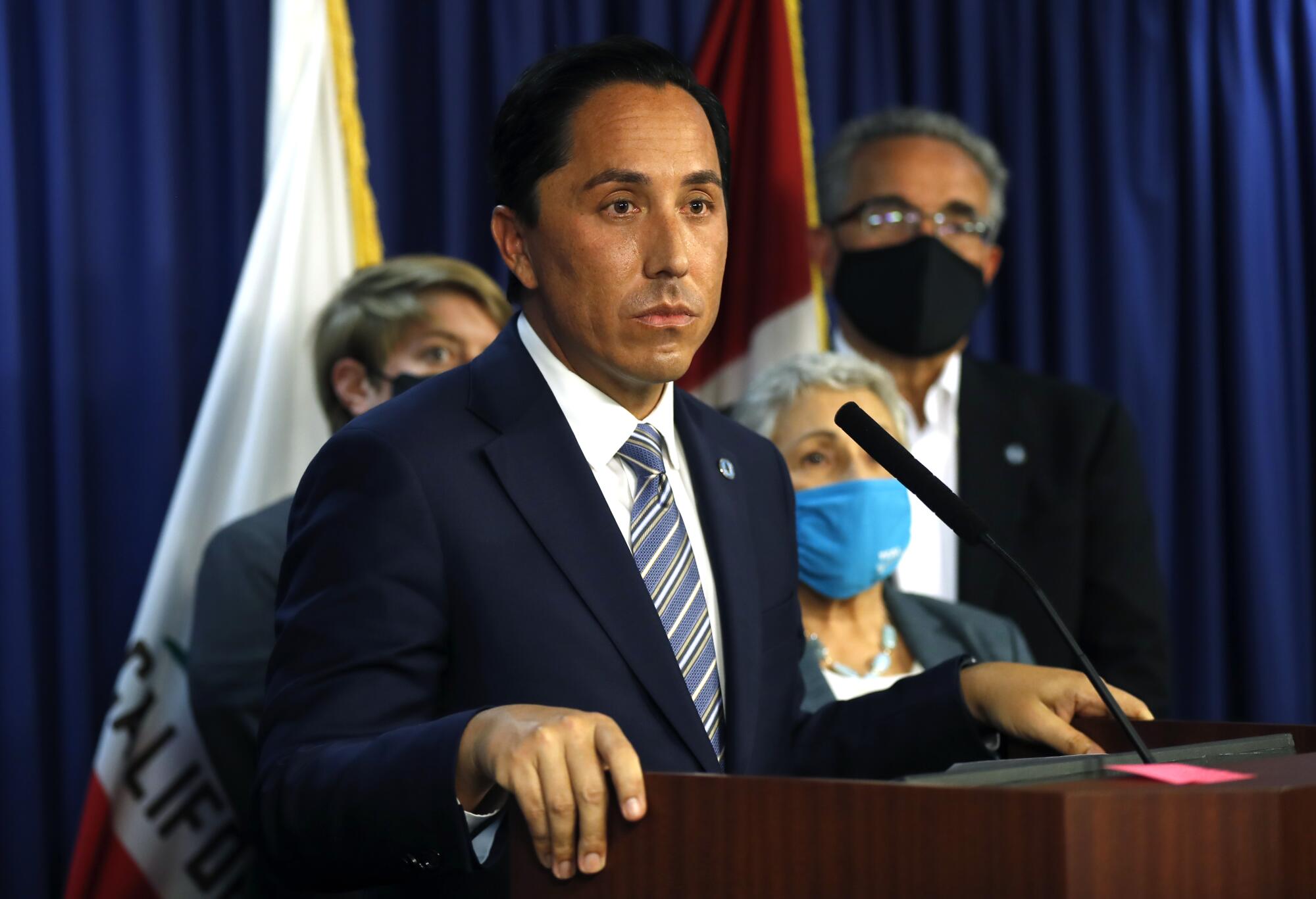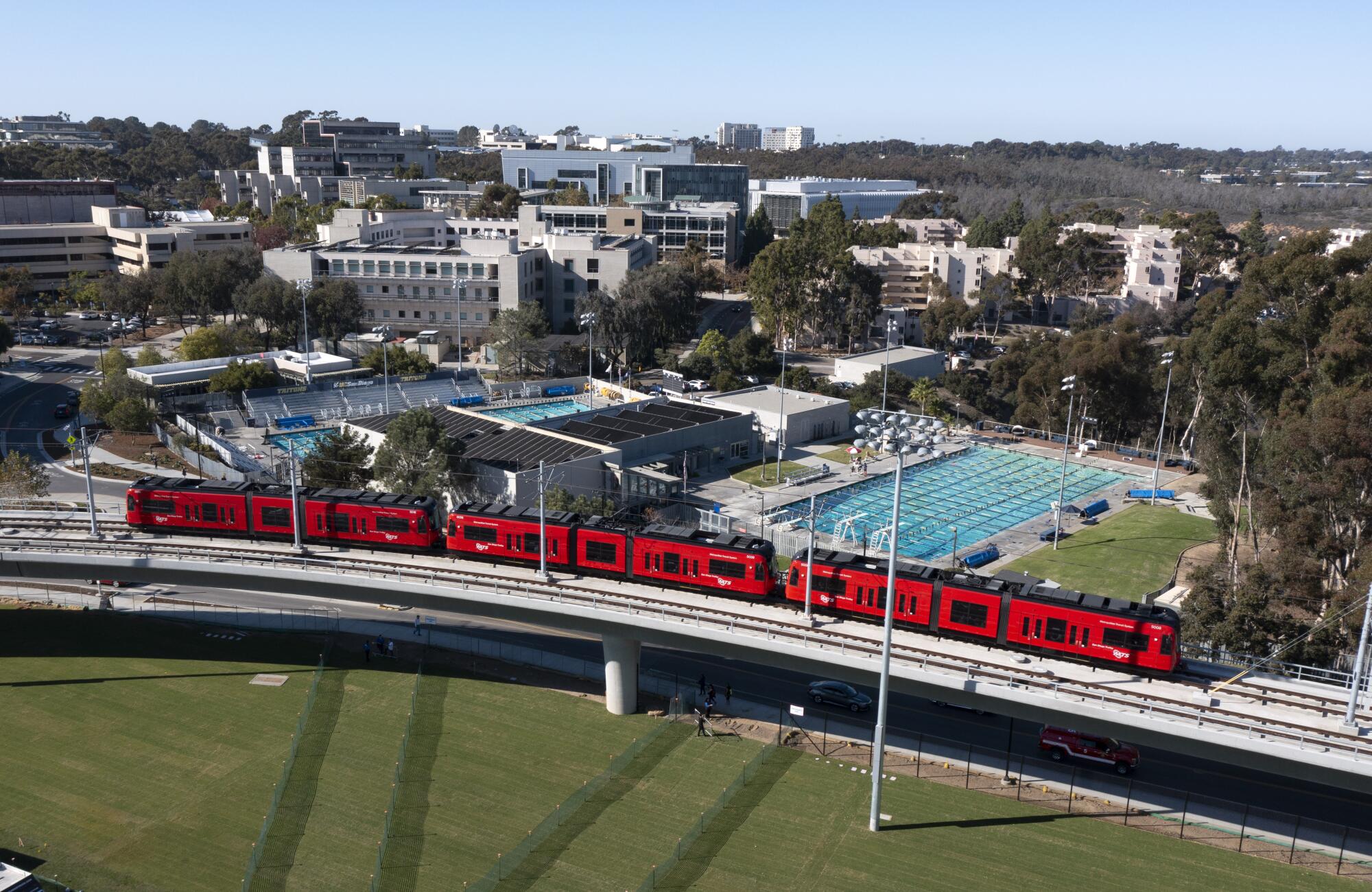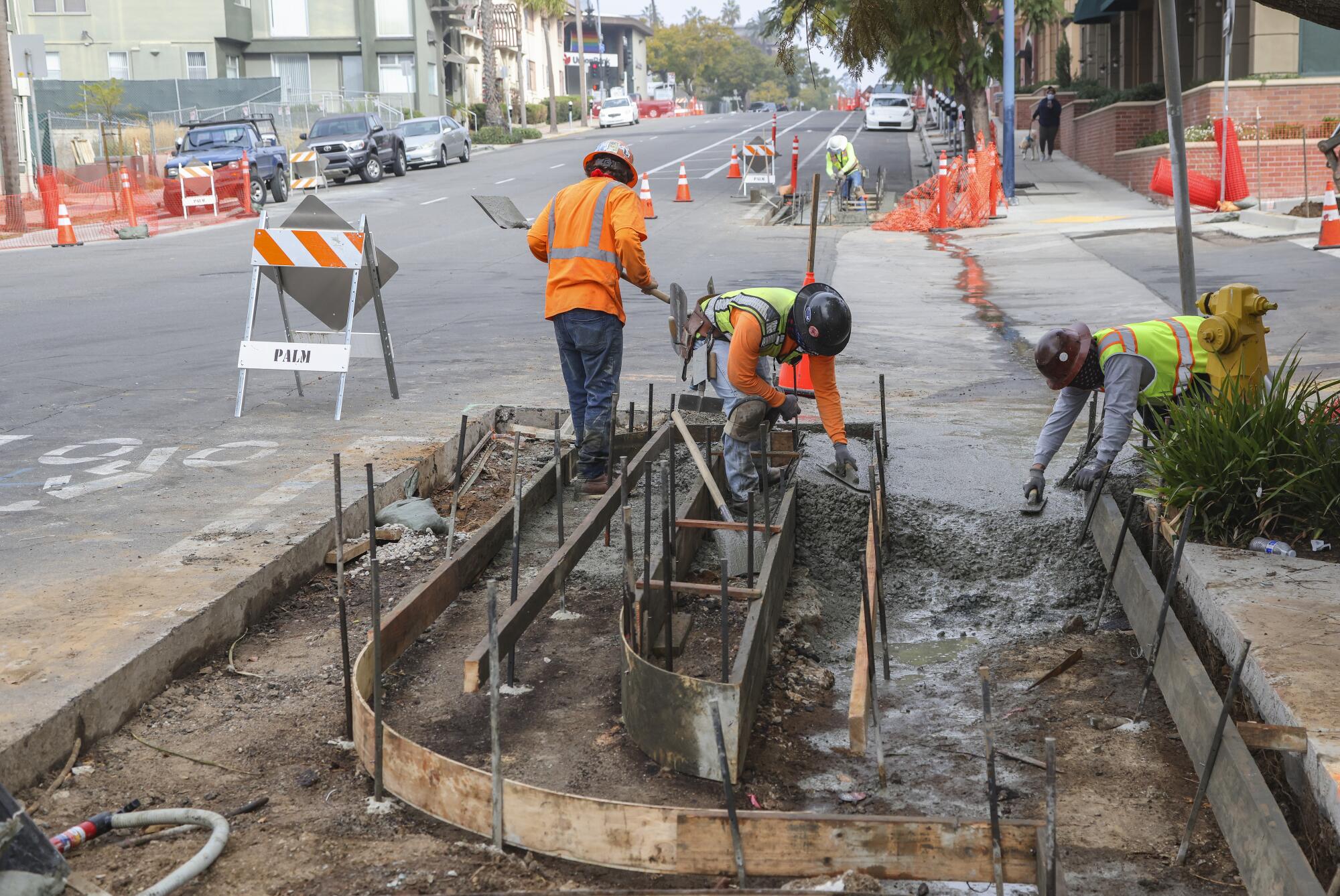
Transportation officials say new rail and bus upgrades, paired with per-mile fees on drivers, is the San Diego region’s best hope to limit traffic congestion
San Diego’s top transportation experts say they have a solution to ever-tightening gridlock traffic that will also curb tailpipe emissions and improve the life of many low-income residents who rely on public transit.
The catch: Voters must embrace multiple tax hikes, including per-mile fees on driving, and endure three-plus decades of massive rail, highway and other construction projects.
This story is for subscribers
We offer subscribers exclusive access to our best journalism.
Thank you for your support.
The blueprint — drafted by the San Diego Association of Governments and approved Friday by its 21-member board of elected officials — reimagines much of the San Diego region by 2050 as a collection of walkable villages serviced by bustling train stations and on-demand shuttles.
“I believe that it’s bold. I believe that it’s ambitious. I believe that it’s representative of the transportation system that we deserve,” said San Diego Mayor Todd Gloria at SANDAG’s public hearing Friday.
Critics of SANDAG’s more than $160 billion vision, which relies on voters approving three sales tax increases by 2028, say the agency is misguided and out of touch with the electorate.
Technology, such as self-driving cars, may help ease congestion in coming decades, they argue, while transit projects that tunnel under homes and businesses will end up mired in neighborhood opposition and quickly become a money pit.
“I don’t want to be in a position where we’ve got a half-built railroad that is not going to be used,” said county Supervisor Jim Desmond, who held a rally with fellow conservative leaders on Thursday to oppose the transportation plan.
Voters will have the ultimate say. Organized labor and environmental groups are teeing up the first in a series of half-cent sales tax increases for the 2022 ballot. San Diegans will also likely have to approve the plan’s linchpin, a so-called road charge on drivers, which could fluctuate with traffic congestion to dissuade unnecessary trips during rush hour.
While elected officials spar over the plan’s broad strokes, construction work will roll out in phases, with details almost certain to change over time. In fact, SANDAG’s regional transportation plan will be updated every four years.
Los Angeles at 110 mph
SANDAG hopes to complete a suite of projects through 2025 to kickstart its vision.
Most notably, the plan includes $1.2 billion to finish double tracking the coastal rail corridor along Interstate 5, which services Amtrak as well as freight carriers. The upgrades would cut commute times in half between downtown San Diego and Los Angeles, according to SANDAG, with top speeds increasing to roughly 110 miles an hour, up from about 60 miles an hour today.
The commuter rail line, which currently terminates at the Santa Fe Depot, would connect to a new “San Diego Grand Central” in Old Town or another nearby location. The massive transit hub would also provide riders with a link to the downtown airport and is slated to be under construction by the middle of the decade.
“By 2025, the Central Mobility Hub, regardless of where it is, will not be complete, but it will be under construction,” said SANDAG Executive Director Hasan Ikhrata.
The plan also puts around $480 million toward the new Otay Mesa II border crossing, which is slated for completion by fall 2024. The new port of entry is expected to dramatically reduce border wait times for commercial trucks that often hit four to eight hours.
A significant amount of funding is slated for bicycle improvements, including to help finish portions of SANDAG’s 70-mile regional bicycle network. The plan, which includes overhauling streets with roundabouts, traffic-protected bike lanes and other improvements, has proven more complicated and expensive than the agency first imagined when it approved the idea in 2013.
The San Diego Metropolitan Transit System’s Rapid bus network, which uses dedicated guideways on roads and highways, would also get a big boost. For example, there’s money to improve connections between Spring Valley and downtown San Diego, as well as between La Mesa and Ocean Beach. There’s also funding to help pay for zero-emission buses.
A major part of SANDAG’s plan is building out more than 800 miles of express or “managed” lanes that service buses, carpools and toll-paying customers. FasTrak users can already pay to ride in such a lane along Interstate 15 south of Escondido, where prices increase in response to traffic congestion.

About $582 million would fund streetlight synchronization and automated upgrades to improve traffic flows. This technology, for example, could respond in real-time to allow buses and emergency vehicles to move more smoothly through congested urban corridors. San Diego currently has very little light synchronization.
“We need to take the chaos that we currently have and coordinate it, and that’s what this technology allows us to do,” said Ray Major, SANDAG’s chief economist. “If there’s something happening at the stadium, they change the synchronization to allow that traffic to flow out.”
More than $100 million would go to promote the adoption of electric vehicles, including building new charging stations by 2025. Another roughly $310 million would fund the construction of so-called mobility hubs, where drivers can charge cars, motorized scooters and other vehicles. These areas would also serve as a central location to connect with services such as Uber and Lyft, as well as future on-demand buses or shuttles.
Nearly 30 percent of the spending through mid-decade, roughly about $2 billion, would get kicked back to local cities for road and other transportation improvements by 2025.
Fees for drivers
The most controversial part of the plan, charging drivers per-mile fees, doesn’t come until 2030. That’s when SANDAG officials expect the state to roll out its collection system for such road charges.
California launched a pilot in 2015 at the direction of the legislature. The program, overseen by the California Transportation Commission, trails similar efforts in Utah and Oregon.
The idea is to find a replacement for declining revenue from the state’s gas tax as people increasingly drive electric and more fuel-efficient cars. SANDAG hopes it can tack its regional fee on the state’s future road charge, totaling about four cents a mile.
However, transportation experts agree that such charges aren’t just about collecting tax revenue. The state is currently exploring technology that can collect real-time location data to discourage gridlock traffic with higher fees.
“Transit doesn’t reduce congestion,” said Jim Moore, director of the transportation engineering program at the University of Southern California. “If congestion relief is the goal, then it’s the most controversial part of the plan that you all should be focused on, which is the mileage fees.”
Republicans have blasted the idea of so-called road charges for months, arguing that they would unfairly burden motorists. Progressives have countered that they’re more equitable than the current gas tax because the state could subsidize low-income drivers.

However, following a public uproar, Gloria and other Democrats on the SANDAG board, including Encinitas Mayor Catherine Blakespear, National City Mayor Alejandra Sotelo-Solis and Chula Vista Mayor Mary Salas, backed away from the idea.
On Friday, Gloria asked SANDAG to report back on alternative funding sources to the road charges, citing the potential to pull in money from the $1.2 trillion national transportation stimulus bill.
“I believe the inclusion of a road-user charge is not necessary for this plan to be successful,” he said Friday. “Residents need to have more feasible and accessible transit alternatives other than a car before a road-user charge can truly be effective.”
That creates an issue for SANDAG, which has long relied on the prospect of road charges to reduce greenhouse gases from cars and increased transit use. Ikhrata has agreed to study the idea of ditching the tool. However, the agency would not only have to find a major new funding source but could be in danger of missing state mandates to limit greenhouse gas and per-capita driving.
Under the current plan, SANDAG expects to meet Sacramento’s expectations with flying colors. By 2050, the agency envisions that nearly one in three people in downtown San Diego will use rush-hour transit, up from less than one in five today. National City would see a similar jump.
Without road charges, it’s unclear whether the agency could even come close to hitting those marks.
A recent Union-Tribune editorial points out that Los Angeles spent billions of dollars adding hundreds of miles of rail over the last three decades, only to see transit use decline.

Neighborhoods get a vote
SANDAG’s plan really starts to make progress on major projects by 2035. That’s when it expects to finally connect transit to the airport via some form of “people mover” system and build out a long-awaited Purple Line rail project slated to run between National City and the city of San Diego’s neighborhoods City Heights, Kearny Mesa and University City.
However, some critics have questioned whether such major projects will be ground to a halt by neighborhood opposition as plans start to crystallize around specific areas.
It’s an issue the state has faced with its high-speed rail project, and L.A. is no stranger to seeing rail projects slowed down as wealthy communities band together to oppose projects in court.
“It’s not unusual to find neighborhood opposition,” said Michael Manville, a professor of urban planning at UCLA’s Luskin School of Public Affairs, “But the extent of neighborhood opposition varies a lot.”
SANDAG has had issues dealing with the public before, most notably over the removal of parking spaces in its bicycle-lane program. Business and neighborhood opposition has delayed projects by years. Recently, the agency announced the price tag for its regional bike network has ballooned from an initial $200 million to $446 million.

The agency also recently delivered the region’s largest-ever infrastructure project on time and on budget with the Blue Line trolley extension from downtown San Diego to University City.
“We have a history of delivering,” Ikhrata said. “We’re trying to prove to people that we mean what we say, and we say what we mean.”
Ethan Elkind, a transportation expert and director of the climate program at UC Berkeley’s Center for Law, Energy and the Environment, said the SANDAG plan shouldn’t be compared to the state’s high-speed rail debacle.
“The problems with the statewide version are myriad, from the counter-productive strings attached to the federal dollars it received, agency mismanagement, and the insufficient funding tied to the project along with wildly inaccurate initial cost estimates,” he said. “San Diego’s system would presumably have fewer of these obstacles to deal with, especially if they can build in existing rights-of-way.”
However, he points out that for such a massive transit overhaul to be successful, the region would have to promote housing density, overhauling entire neighborhoods.
Transforming even pockets of sprawling Southern California into dense communities thriving on transit has proven extremely difficult over the past two decades.
Transit works in compact, vertical cities like New York and San Francisco. But San Diegans have shown little tolerance for the snarling traffic and parking wars that come with such urbanization.
Of course, that’s what it takes to make transit work, unless perhaps, leaders are willing to take on car culture with road charges.
“The most effective way to build back transit ridership is to allow more apartment buildings to be built near transit hubs,” Elkind said. “That would counter the decrease in transit ridership in the region, as would congestion mileage fees on single-occupant vehicle trips.”
Get Essential San Diego, weekday mornings
Get top headlines from the Union-Tribune in your inbox weekday mornings, including top news, local, sports, business, entertainment and opinion.
You may occasionally receive promotional content from the San Diego Union-Tribune.
